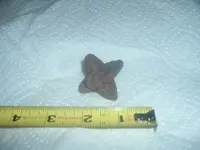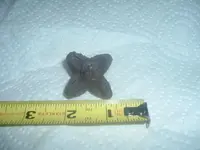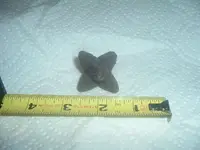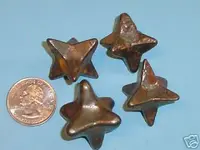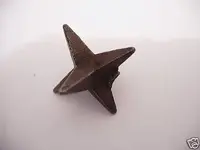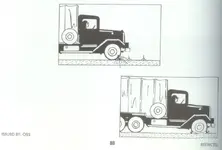Creskol and Fmerg are correct ...the item is definitely not a Caltrop (also known as a horse-cripplers or crows-feet).
Caution-note: This is a very long post, containing extensive documentation. Readers who get bored easily may wish to skip it, or read only a few paragraphs.
First and foremost... a Caltrop
always had only 4 arms/spines - which were arranged in a Tetrahedral pattern, so that no matter how the Caltrop lands one on the ground, one of its sharp-tipped arms/spines would be pointing straight upward, to impale a horse's hoof or a soldier's booted foot. See
http://en.wikipedia.org/wiki/Caltrop
The 6-armed "not-a-Caltrop" shape is known as a jackstone ...due to its resemblance to the jacks in the children's game "Balls & Jacks."
I've done very extensive research to discover the actual identity of these 6-armed iron "relics," because they are frequently sold on Ebay as being Caltrops. They are actually "tumbler media" from the Metalcasting Industry. (Some others are antique Jackstones, from the children's game.) In the Metalcasting industry, they are known by several names... a tumbler-star/jack-star/mill-star. They are used to clean casting-sand, flashing, and burrs from "raw" cast metal objects. To clean the raw castings, a batch of these "stars" and raw castings were put into a tumbler barrel (sometimes called a tumbler-mill). The barrel was then slowly rotated on its axis, causing its contents to tumble, and the stars would batter the castings, knocking the casting-sand and burrs off the castings. The purpose of the iron star's pointed arms was to reach into the holes, crevices, and inverse-angles of the castings. (Ball-shaped tumbler-media is used for castings which don't have holes, crevices, or inverse-angles.)
Last year, my research turned up an Encyclopedia of Metal-Casting on the internet, with a diagram which showed these 6-armed items as Tumbler Media ...but my computer's hard-drive died, beyond repair or restoration, so I lost the link to that online document.
Unfortunately, it's deep in human nature to very much prefer to believe you've come into possession of a rare & valuable Military Antique ...instead of a low-value modern-era item. So, some people are going to keep on resolutely insisting the item is a Caltrop.
But, readers, please ask yourself, if these items are actually a Caltrop (which needed to be used in large numbers to be effective), why aren't these 6-armed items
ever dug in large numbers? Instead, the very few that have been dug are always found only one (or perhaps two) at a time.
Also, if Caltrops were used in the US civil war, why doesn't the term caltrop/caltrops/horse-cripplers/crows-feet get mentioned in
any report (or correspondence) in the entire 126-volume set of the Official Records of the Union and Confederate Armies"? If they were used, they'd get mentioned in at least
one of the reports (or correspondence) ...right?
Lastly, if these 6-armed items are really a Caltrop, why do we see so many of them in nice clean non-excavated (non-dug) condition for sale on Ebay? (See the attached photos ...one showing tumbler-media with worn-out tips, and one showing fresh, sharper tips.) Which case do you think is more likely -- that they are rare valuable military-antique Caltrops, or surplus 20th-century Tumbler-Media?
Here are many links (and observations) from my research in 2009. (Of course, links to the Ebay auctions are now expired.) Please remember to view the photos at the end of this post.)
---------------------------------
A caltrop can only have its intended effect it is sharp-pointed. Please note
that the tips of these six-armed items are not sharp enough to stab through
shoe-leather, much less a horse's foot.
To be significantly effective, caltrops need to be distributed on the ground "in
quantity" ...so why do relic-diggers find only one caltrop at a spot?
In olden times, caltrops were also called crows-feet.
http://moa.cit.cornell.edu/moa/browse.monographs/waro.html
(SEARCHABLE online complete 125-volume set of "The War of the Rebellion: a
Compilation of the Official Records of the Union and Confederate Armies")
URL for an Ebay seller's statement that he bought "caltrops" among some old
kid's-game Jacks:
http://cgi.ebay.com/ws/eBayISAPI.dl...sid=m37&satitle=260188024561&category0=&fvi=1
Item number: 260188024561
Seller: save2barns
End time: Dec 03 2007, 19:13:10 PST
Description:
2 very old antique caltrop caltrops. These 2 were in a lot of jacks I
purchased, the jacks were dated to 80+ yrs old. Each is approximately 1"
from one point to the other. they are a heavy metal cast iron. Look like
they were made from a mold as each has remnants of where they may have been
attached. very minor surface rust on these.. great old items!!
I have found a modern-day statement that the VERY-STUBBY-TIPPED form of these
six-armed items were used at early 20th-century Iron Foundries "to clean/polish
sand from iron castings":
http://www.thetreasuredepot.com/cgi-bin/detecting/detecting_config.pl?noframes;read=84110
(discussion of a dug six-armed iron item - note particularly the reply at:
http://www.thetreasuredepot.com/cgi-bin/detecting/detecting_config.pl?noframes;read=84110
and the digger's photo of two of them at:
http://www.thetreasuredepot.com/cgi-bin/detecting/detecting_config.pl?noframes;read=84111
Caltrop URLs
A caltrop's shape/form is a called a Tetrahedron, so here's the word Tetrahedron
defined, and pictured - and in addition to that picture, the article also
includes a photo of a modern-day Caltrop (to demonstrate their Tetrahedral
shape/form):
http://gwydir.demon.co.uk/jo/solid/tetra.htm
Wikipedia entry on Caltrop, with several photos of actual Caltrops:
http://en.wikipedia.org/wiki/Caltrop
Because a disbelieving seller says Wikipedia info is unreliable, here's the
modern-day American Heritage Dictionary's definition of a caltrop, describing it
as having FOUR spikes, and how it works:
http://www.bartleby.com/61/34/C0043400.html
An 18th-century Military Dictionary, describing Caltrops as being FOUR iron
spikes in a tetrahedron pattern, 3 to 4 inches tall:
http://footguards.tripod.com/01ABOUT/01_dictionary.htm
Caltrop defined as having 4 spikes at the US Central Intelligence Agency
website:
https://www.cia.gov/about-cia/cia-museum/cia-museum-tour/flash-movie-text.html
Photo of the single caltrop specimen excavated by archeologists at an early
Colonial-period Jamestown VA site:
http://www.thepirateking.com/historical/caltrop.htm
SpanAmWar US Army Corps Badges - see 4th Corps, used because a caltrop always
has just FOUR points:
http://www.spanamwar.com/medalscorpsbadges.htm
Article titled "The Caltrop As Anti-Tank Obstacle" which includes a photo of a
very large World War 2 anti-tank CONCRETE Caltrop obstacle:
http://www.britarch.ac.uk/projects/dob/crom1b.html
Discussion at RomanArmyTalk forum, with photo of ancient caltrop, and also
including the ancient Roman historian Vegetius' description of a caltrop:
http://www.romanarmy.nl/rat/viewtop...=caltrop&sid=4d56a45f3d52521f9fe0532d30d278c4
The (British) National Army Museum website's Definition of caltrops, with a
photo of 16th-century Caltrop in the British National Army Museum collection:
http://www.national-army-museum.ac.uk/exhibitions/shortVisits/animals/page2.shtml
Scanned page in an 1880s dictionary, see its definition of CROWS-FEET/caltrops,
saying four points:
http://books.google.com/books?id=WA...sig=SJ7eOJDxzxn6BL9QvNydTISCJs8#PRA1-PA181,M1
Current Ebay auction for a European Medieval caltrop by a seller in England -
note that he says "The design is such that whichever way a caltrop is thrown
onto the ground and lands, there is always a spike pointing upwards."
http://cgi.ebay.com/SUPERB-MEDIEVAL...ageNameZWD2VQQcmdZViewItem?_trksid=p1638.m122
Current Ebay auction for a Medieval caltrop by a seller in Germany - note that
he says "No matter how you throw it, one of the spikes is always up."
http://cgi.ebay.com/CALTROP-MEDIEVA...ryZ73464QQssPageNameZWDVWQQrdZ1QQcmdZViewItem
Current Ebay auction for a Medieval/Roman caltrop - note that the seller says
"No matter how you dropped them, one sharp spike always remained upward."
http://cgi.ebay.com/MEDIEVAL-CALTRO...ryZ37907QQssPageNameZWDVWQQrdZ1QQcmdZViewItem
URLs proving THE EXISTENCE OF IRON JACKSTONE-TOYS IN THE 1800s ERA
An 1875 newspaper report of a child's death from swallowing an IRON JACKSTONE
TOY.
http://njsuttonfamily.org/Newspaper/jan1875.htm
A May 1886 article in "The Medical and Scientific Reporter" about the death of a
young girl who swallowed "an iron Jackstone.":
http://books.google.com/books?id=1B...ts=MGqe35IvVF&sig=WzFFS3l7c9OmWxWQqT0OWN_ep3Q
A 1901 article in The Therapeutic Gazette, about surgically removing "an iron
jackstone" that was swallowed by "a small colored child."
http://books.google.com/books?id=zb...ts=pDo1MLDPKM&sig=SEK491eJN3HvOTXPPHsxtHuRnCU
URLs SHOWING THE "JACKSTONE SHAPE/FORM":
Article showing huge CONCRETE jackstones used for rip-rap at a Lake Dam, with
photos and info:
http://www.nebraskastudies.org/0800...braskastudies.org/0800/stories/0801_0504.html
clipart.com's illustration of a 20th-century jackstone TOY
http://www.clipart.com/en/search/split?q=jackstone&a=i
Photo of an Origami (Japanese paper-folding art) jackstone (4th image on
webpage)
http://ccnuma.anu.edu.au/~wpc/origami/19990526/
Video of making a jackstone by Origami (Japanese paper-folding art)
http://vids.myspace.com/index.cfm?fuseaction=vids.Channel&ChannelID=47691104


